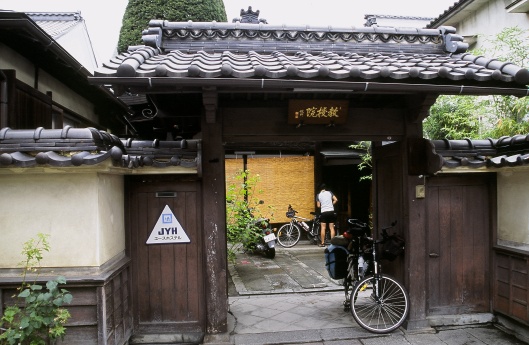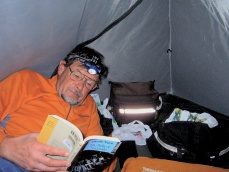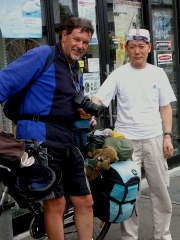
|
|
|
|
Ads by Infohub Partnership with TGCT Mutual Support with JCA |
3. Contented life of a bicycling nomad
Cycling soon establishes its own routine. Convenience stores found at regular intervals provided daily needs - breakfast, toilet, lunch, afternoon refreshments, and often evening meals. Breakfast of an onigiri (seaweed covered rice ball with filling of salmon, pickled plumb or fish roe) and canned hot coffee, was typically early. The convenience store Post Box was just the ideal height for a breakfast table. And the convenience store welcome, with smiling staff shouting Irsshaimase was a constant delight. We had planned to stay at YHA hostels, business hotels, Cycling Terminals which were like upmarket backpackers, and we camped. We frequently camped in nice parks without being admonished. Such antics seemed to be acceptable if we arrived late and departed soon after daybreak. We sometimes slept in country railway stations and once on a station platform.
Working on an average of one rest day in four, 69 days were estimated for the ride to Sata misaki. Average distance per biking day was calculated at 70 kilometres. We reached Hakodate, 777 km from Soya misaki, on the estimated 14th day. In the city I had difficulty getting cash on my Visa. Foreign exchange clerks in large banks could not help when their machines rejected my card. This was frustrating until we discovered humble Post Offices had cash machines that would accept an international Visa. From then on, spotting the distinctive Post Office signs, meant cash availability over the following 10 weeks. I had also discovered a loose bottom bracket which needed a professional bicycle mechanic to tighten. This was not so easy. We visited a number of tiny untidy bike shops where elderly proprietors looked at my mountain bike as if it were rocket science. My Giant was designed in America and built in Taiwan. But hadn't the Shimano componentry originated in Japan? Surely it would be easy to find a repair shop?
The repairman did an excellent job. From this experience we were able to find an appropriate repair shop when necessary. Halfway through the journey my rear wheel cones were replaced. And brake blocks needed to be replaced more often than in New Zealand. Bike mechanics, able to work on our bikes, were typically keen cyclists. Always helpful, they were happy to talk to us about bike travel. Later, one was to tell us, "We do not see bike travellers so often in Japan now. Young people would rather sit in front of a PC screen." I was saddened to hear this. Japan is a wonderful country for a nomadic life on a bicycle. [2. Return to Soya - the Hokkaido journey:] [4. Journeying through Honshu] uploaded:20, 08, 2006
|
|
|
|
Copyright "Japan Cycling Navigator". All
rights reserved.
|



 We were carrying a minimum of clothing and equipment. With everything carefully chosen we were able to remain warm and mostly dry throughout the long journey. As each bike riding day neared an end we would look for a place to camp, a nearby convenience store, and
We were carrying a minimum of clothing and equipment. With everything carefully chosen we were able to remain warm and mostly dry throughout the long journey. As each bike riding day neared an end we would look for a place to camp, a nearby convenience store, and  Eventually we were recommended a small suburban bike shop
Eventually we were recommended a small suburban bike shop 